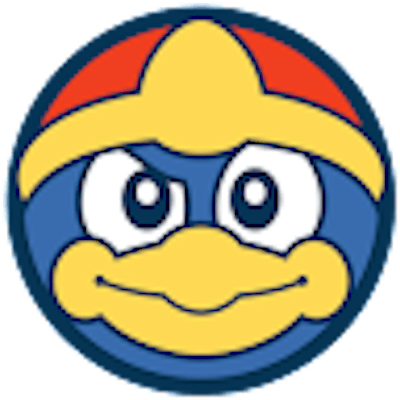CloudFormation : CodePipeline and ECS Blue/Green Deployments (Part II)
Follow me in the understanding of the process of creating a fully-fledged CodePipeline through CloudFormation.
Introduction
In part I of this series, we saw how to setup the pre-requisites I had for my application and then went on creating the first iteration of the CodePipeline which is :
Successfully using a CodeStar connection to a Github repo
Is triggered by changes on the
masterbranch and proceed on pulling the source code, build the Docker image and store it in ECR.
In this part II

If we look at the infra diagram, what we still have to create to complete this setup is:
An ALB with two target groups. We need two target groups so that CodeDeploy with Blue/Green can switch between the newest and oldest ECS tasks.
An ECS Cluster with a Service and an initial task definition. This will let us in a first step ensure we're all good before plugging in our deployment through the CodePipeline.
Load Balancer and Target Groups
In the following iteration of the template :
We create two
AWS::ElasticLoadBalancingV2::TargetGroup, they have the same characteristics (except for their name) and are supposed to target an app responding to port 4000 (remember, it's my Phoenix app running on the default port).
There is nothing wrong with this behavior, as our listeners will be facing the internet and supporting incoming 80/443 requests, and communicating internally with our app.
Remember that we need two target groups as they are at the core of this blue/green mechanism.We create the ALB itself, nothing crazy, an internet-facing ALB.
We create two listeners:
The first one is an HTTPS listener that needs a reference to a certificate, as I want my app to be accessible under a secure domain.
The second one is a redirecting listener, that accepts incoming 80 requests but automatically redirects those to the secure listener. HTTP requests shall not pass!
AWSTemplateFormatVersion: 2010-09-09
Parameters:
CodestarConnectionARN: #...
VpcId: #...
ALBSecurityGroupId:
Type: String
SubnetAId:
Type: String
SubnetBId:
Type: String
TLSCertificateARN:
Type: String
Resources:
ElasticContainerRegistry: #...
ArtifactStoreBucket: #...
PipelineRole: #...
CodeBuildRole: #...
CodeBuildProject: #
Pipeline: #...
ALBTargetGroupBlue:
Type: AWS::ElasticLoadBalancingV2::TargetGroup
Properties:
HealthCheckIntervalSeconds: 30
HealthCheckPath: /
HealthCheckPort: 4000
HealthCheckProtocol: HTTP
HealthCheckTimeoutSeconds: 10
HealthyThresholdCount: 5
Matcher:
HttpCode: 200
Name: Blue
Port: 4000
Protocol: HTTP
TargetType: ip
UnhealthyThresholdCount: 4
VpcId: !Ref VpcId
ALBTargetGroupGreen:
Type: AWS::ElasticLoadBalancingV2::TargetGroup
Properties:
HealthCheckIntervalSeconds: 30
HealthCheckPath: /
HealthCheckPort: 4000
HealthCheckProtocol: HTTP
HealthCheckTimeoutSeconds: 10
HealthyThresholdCount: 5
Matcher:
HttpCode: 200
Name: Green
Port: 4000
Protocol: HTTP
TargetType: ip
UnhealthyThresholdCount: 4
VpcId: !Ref VpcId
ALB:
Type: AWS::ElasticLoadBalancingV2::LoadBalancer
Properties:
Name: myapp-alb
Scheme: internet-facing
SecurityGroups:
- !Ref ALBSecurityGroupId
Subnets:
- !Ref SubnetAId
- !Ref SubnetBId
Type: application
ALBListenerHTTPS:
Type: AWS::ElasticLoadBalancingV2::Listener
Properties:
Certificates:
- CertificateArn: !Ref TSLCertificateARN
DefaultActions:
- Type: forward
ForwardConfig:
TargetGroups:
- TargetGroupArn: !Ref ALBTargetGroupBlue
Weight: 1
LoadBalancerArn: !Ref ALB
Port: 443
Protocol: HTTPS
ALBListenerRedirect:
Type: AWS::ElasticLoadBalancingV2::Listener
DependsOn: ALBListenerHTTPS
Properties:
DefaultActions:
- Type: redirect
RedirectConfig:
Protocol: HTTPS
Port: 443
Host: "#{host}"
Path: "/#{path}"
Query: "#{query}"
StatusCode: HTTP_301
LoadBalancerArn: !Ref ALB
Port: 80
Protocol: HTTP
ECS Application
Before completing the Pipeline, which will be described in the dedicated and last part of this series, we will already make our first "deployment" or installation of the application.
Execution Role
The ECS Task itself will need some permissions to operate. In my specific case, permissions to access the ECR repository and the Cloudwatch Logs.
You may need to require environment variables, in that case, you should either provide permissions for the SecretManager or an S3 bucket.
Every time you wonder how specific you can go or which additional params you can give to a resource, just google the resource type such as AWS::IAM::Role and you will land on exhaustive documentation from the resource and property reference https://docs.aws.amazon.com/AWSCloudFormation/latest/UserGuide/aws-template-resource-type-ref.html
AWSTemplateFormatVersion: 2010-09-09
Parameters:
CodestarConnectionARN: #...
VpcId: #...
ALBSecurityGroupId:
Type: String
SubnetAId:
Type: String
SubnetBId:
Type: String
TLSCertificateARN:
Type: String
Resources:
ElasticContainerRegistry: #...
ArtifactStoreBucket: #...
PipelineRole: #...
CodeBuildRole: #...
CodeBuildProject: #
Pipeline: #...
ALBTargetGroupBlue: #...
ALBTargetGroupGreen: #...
ALB: #...
ALBListenerHTTPS: #...
ALBListenerRedirect: #...
ExecutionRole:
Type: AWS::IAM::Role
Properties:
RoleName: execution-role
AssumeRolePolicyDocument:
Version: 2012-10-17
Statement:
- Action: sts:AssumeRole
Effect: Allow
Principal:
Service: ecs-tasks.amazonaws.com
Policies:
- PolicyName: ecr-access
PolicyDocument:
Version: 2012-10-17
Statement:
- Effect: Allow
Action:
- ecr:BatchCheckLayerAvailability
- ecr:GetDownloadUrlForLayer
- ecr:BatchGetImage
Resource: !GetAtt ElasticContainerRegistry.Arn
- Effect: Allow
Action:
- ecr:GetAuthorizationToken
- logs:CreateLogGroup
- logs:CreateLogStream
- logs:PutLogEvents
Resource: '*'
Task Definition
Now our role has been defined, we can define the ECS Task itself, which grossly speaking means which containers to run and what resources to allocate (obviously more than just that but it gives you a first good picture).
As we only have an image, this task will only consist of one container with some resources. Maybe notice the RequiresCompatibilities, which indicates we are going for Fargate and we are not managing any underlying EC2. We give containers to AWS and it makes those run for us with the needed resources, life is easy.
AWSTemplateFormatVersion: 2010-09-09
Parameters:
CodestarConnectionARN: #...
VpcId: #...
ALBSecurityGroupId: #...
SubnetAId: #...
SubnetBId: #...
TLSCertificateARN: #...
Resources:
ElasticContainerRegistry: #...
ArtifactStoreBucket: #...
PipelineRole: #...
CodeBuildRole: #...
CodeBuildProject: #
Pipeline: #...
ALBTargetGroupBlue: #...
ALBTargetGroupGreen: #...
ALB: #...
ALBListenerHTTPS: #...
ALBListenerRedirect: #...
ExecutionRole: #...
TaskDefinition:
Type: AWS::ECS::TaskDefinition
Properties:
RequiresCompatibilities:
- FARGATE
ExecutionRoleArn: !GetAtt ExecutionRole.Arn
Cpu: 256
Memory: 512
NetworkMode: awsvpc
ContainerDefinitions:
- Name: myapp
Image: !Sub
- '${Repository}:latest'
- Repository: !GetAtt ElasticContainerRegistry.RepositoryUri
MemoryReservation: 256
Memory: 512
PortMappings:
- ContainerPort: 4000
HostPort: 4000
Protocol: tcp
LogConfiguration:
LogDriver: 'awslogs'
Options:
"awslogs-group": "/ecs/myapp-production"
"awslogs-create-group": "true"
"awslogs-region": "eu-central-1"
"awslogs-stream-prefix": "ecs"
ECS Cluster and Service
Now our task is defined, we can try our first (manual, at this stage) deployment on ECS by provisioning the Cluster and the Service.
By saying manual, I mean that provisioning and linking our task definition will cause ECS to actually deploy the task on those resources.
This may not be needed as our goal is to give the hand to CodePipeline in terms of load balancing targets and tasks management, but it's a good milestone to see that our stuff is working and then proceed with the final steps of the automation itself. Upon running this template, you should be able to access your app through the LoadBalancer endpoint.
Once again, nothing crazy:
We set up the cluster itself
We declare a service linking the
bluetarget group with a task definition to spin up our app. As already discussed before, this template is "hardcoding" the fact thatblueis the target group associated to the task, this means that if you run the template with modifications in the ECS Service afterward, it will automatically and by default assign blue as the currently used target group, and this may break what CodePipeline did (if the current was green).
AWSTemplateFormatVersion: 2010-09-09
Parameters:
CodestarConnectionARN: #...
VpcId: #...
ALBSecurityGroupId: #...
SubnetAId: #...
SubnetBId: #...
TLSCertificateARN: #...
Resources:
ElasticContainerRegistry: #...
ArtifactStoreBucket: #...
PipelineRole: #...
CodeBuildRole: #...
CodeBuildProject: #
Pipeline: #...
ALBTargetGroupBlue: #...
ALBTargetGroupGreen: #...
ALB: #...
ALBListenerHTTPS: #...
ALBListenerRedirect: #...
ExecutionRole: #...
TaskDefinition: #...
ECSCluster:
Type: AWS::ECS::Cluster
Properties:
ClusterName: myapp-ecs-cluster
ECSService:
Type: AWS::ECS::Service
Properties:
Cluster: !GetAtt ECSCluster.Arn
DeploymentConfiguration:
MaximumPercent: 100
MinimumHealthyPercent: 0
DeploymentController:
Type: CODE_DEPLOY
DesiredCount: 1
LaunchType: FARGATE
LoadBalancers:
- TargetGroupArn: !GetAtt ALBTargetGroupBlue.TargetGroupArn
ContainerName: myapp
ContainerPort: 4000
NetworkConfiguration:
AwsvpcConfiguration:
AssignPublicIp: "ENABLED"
SecurityGroups:
- !Ref ApplicationSecurityGroupId
Subnets: [!Ref SubnetAId, !Ref SubnetBId]
SchedulingStrategy: REPLICA
ServiceName: myapp
TaskDefinition: !Ref TaskDefinition
What's next?
In addition to your first CodePipeline, you now have a running app on an ECS Cluster!
The final missing piece is making the pipeline able to deploy further versions of your app on that cluster and enjoy continuous deployment from your Github repository.

